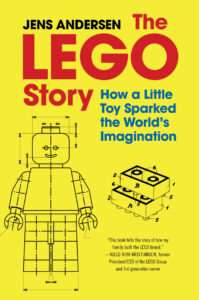
How LEGO Marked and Marketed the Fall of the Berlin Wall
Jens Andersen on a Toy Company’s Role in Commemorating History
When the Berlin Wall fell on Thursday, November 9, 1989, it was a moment of living history. The following week, The Evening Standard referenced a striking full-page ad printed in two other British Sunday papers. It declared that the three best reactions to the extraordinary events in Berlin had come from Chancellor Helmut Kohl, Prime Minister Margaret Thatcher—and LEGO.
The story of how a Danish toy company ended up being mentioned in this context exemplified the spontaneity and drive that LEGO’s managing director had begun to feel was lacking in his organization.
On the afternoon of Friday, November 10, LEGO’s UK sales office got a call from its regular advertising agency, WCRS. The creative director was on the line, having just faxed through an idea for an ad related to the event the whole world was talking about, and he asked Clive Nicholls, LEGO’s British Head of Marketing, to take a look at the idea as soon as possible.
Like billions of other people across the globe, Nicholls had been watching history unfold in Berlin. Glued to his television screen that morning, he saw one clip after another of euphoric, cheering East Germans crawling over the wall with hammers and chisels, or crossing the border into West Berlin in an endless stream.
When Nicholls saw the fax with the advertising agency’s sketch, he was beside himself with excitement. The idea was genius. A motley crowd of Minifigures surged across the border at the Berlin Wall, built out of bricks. On top of the wall were more Minifigures, hammering away at the hated wall, and in the background, you could make out the Brandenburg Gate, with the words “The perfect Christmas gift” hovering above the distinctive gate, which was supported by Doric columns. All of it was built out of LEGO.
It was a once-in-a-lifetime opportunity. Clive Nicholls knew that he and LEGO were unlikely to get another chance to send such a striking message with their advertising, to pay tribute to democracy and freedom, while at the same time reminding millions and millions of consumers that LEGO was ready for the upcoming Christmas season.
Over the following years, as the borders opened one by one in Eastern Europe, sales of LEGO’s products shot up behind the former Iron Curtain.
WCRS was able to have the ad ready to print in the Monday papers, if LEGO was on board with the idea. Clive Nicholls answered that it had to be in the Sunday papers, when the celebratory mood was still at fever pitch. Whatever the cost. It turned out that only two papers could squeeze in a full-page ad right before the deadline; it was then Saturday morning at nine-thirty. But the Sunday Telegraph and Sunday Correspondent had a combined circulation of more than one million readers, and it would still have a significant impact, the ad agency believed.
That there were only eighteen hours before the deadline was one consideration. The cost was something else. Thirty thousand pounds was a lot of money, and there was no room for it in LEGO’s advertising budget. For the first time that Friday afternoon, Nicholls hesitated. Did he want to take responsibility for an ad that wasn’t just expensive, but also made a political statement, breaking with the LEGO Group’s guidelines? Nicholls reached for the telephone and called his boss, Gordon Carpenter. No answer. His boss had left for the weekend and was apparently unreachable.
Taking a deep breath, Nicholls set the process in motion. A lot of employees suddenly became unusually busy. The whole LEGO scene—border crossing, Berlin Wall, and Brandenburg Gate—had to be built, populated with several hundred LEGO Minifigures, then photographed. The biggest challenge was acquiring the building materials. At nearly five o’clock on a Friday, four staff members at the agency went careening off in a taxi to Hamley’s on Regent Street, where they cleared the shelves of LEGO bricks, Minifigures, signs, trees, red and white railroad barriers, and everything else they’d need to re-create the jubilant crowds surging toward freedom. Over the next six hours, the model was built, photographed, and made into a print ad. Clive Nicholls slept through most of Saturday, getting up on Sunday to the first signs that LEGO’s ad had attracted as much positive attention as Helmut Kohl’s and Margaret Thatcher’s official statements on the fall of the Wall.
LEGO was heaped with praise over the following days, and the ad was discussed and reproduced in other media. The plaudits rolled in from ordinary people and advertisers, and even their competitors in the toy industry gave them an approving nod. From Brisbane and Bangkok to Boston and, of course, Berlin, there was no doubt that LEGO would be the perfect Christmas gift.
Over the following years, as the borders opened one by one in Eastern Europe, sales of LEGO’s products shot up behind the former Iron Curtain. A steady stream of tourist buses, carrying mainly Polish but also Hungarian and former East German citizens, set off for LEGOLAND every summer, putting extra pressure on the narrow access roads leading to Billund.
_____________________________________

Excerpted from The LEGO Story: How a Little Toy Sparked the World’s Imagination by Jens Andersen. Copyright © 2022. Available from Mariner Books, an imprint of HarperCollins Publishers.
Jens Andersen
Jens Andersen was born in Copenhagen in 1955 and graduated with a PhD in Nordic literature from the University of Copenhagen in 1993. Since 1990, he has written more than ten biographies, including ones on Hans Christian Andersen, Astrid Lindgren, and Tove Ditlevsen.



















